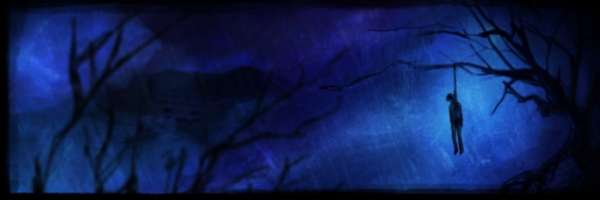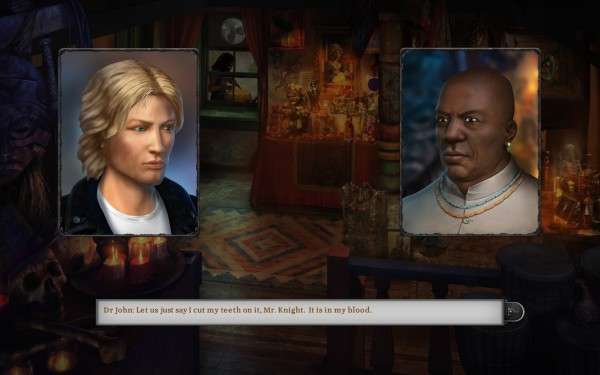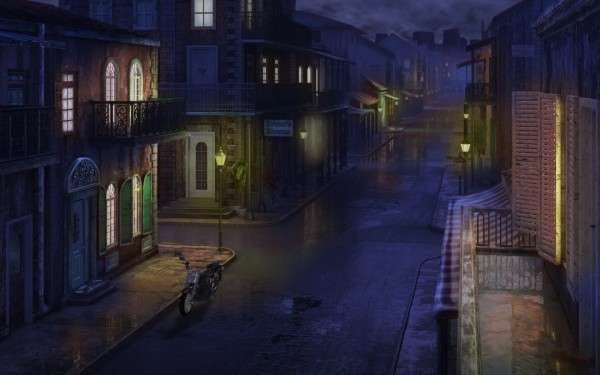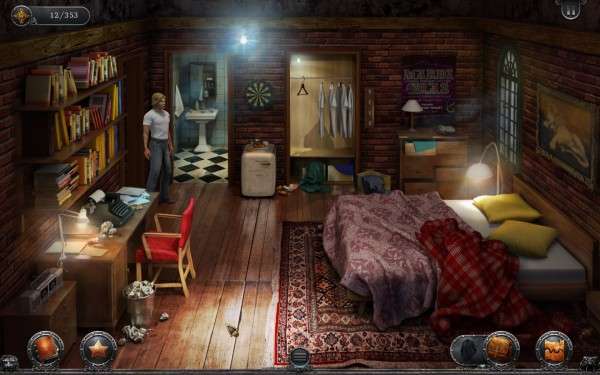
Gabriel Knight: Sins of The Fathers – 20th Anniversary Edition PC Review
Gabriel Knight: Sins of the Fathers was one of my early favourite games. I played it under the best possible circumstances; when I was an impressionable 12 years old. It made me think rugged rogue heroes, trench coats, grim murder mysteries and other noir tropes were the absolute coolest. Along with Beneath a Steel Sky it also helped build a so-far lifelong appreciation of the point & click adventure game genre. Suffice to say, there are reasons why I love Gabriel Knight’s first outing that simply cannot be remade, repackaged and re-sold, and so the best I could hope for is that the more tangible aspects of it still shine when presented in a modern guise.
A few quick words about what we’re dealing with, in case you missed the preview: Gabriel Knight: Sins of the Fathers is a point & click adventure game that was originally released back in 1993. The game was developed and published by Sierra-Online and designed and written by Jane Jensen. Coming up on its 20th anniversary in 2013, now-rights holder Activision were persuaded to lend Jane Jensen the license in order for her new studio, Pinkerton Road – headed up by her and her husband, Robert Holmes, composer on the original – to tackle a remake. For Gabriel Knight: Sins of the Fathers 20th Anniversary Edition they partnered once more with Phoenix Online Studios – developers of Cognition: An Erica Reed Thriller and the Jensen-written Moebius: Empire Rising.
Sins of The Fathers stars Gabriel Knight, a struggling writer living in the back of a book store in New Orleans. In the course of collecting material for his upcoming voodoo-themed murder mystery he gets entangled in a real life voodoo murder mystery. Aside from a rotating roster of lady friends that we never see, closest to Gabriel is Grace Nakimura – book store clerk and secretary, and Franklin “Mostly” Mosely – detective at the New Orleans Police Department. Gabriel is awoken every night by bizarre nightmares, something he brushes aside until an encounter with a gorgeous socialite named Malia Gedde – whom he immediately feels a strong attraction to – draws him into a world where they start making sense.
There are some obvious caveats up top. The voice cast is brand new. No more Tim Curry, no more Mark Hamill. If you’ve played the original, the new line readings take some getting used to, with new Gabriel’s “charm” being especially tough to suffer through at times. He has a tendency to over-act his quips and “charming remarks”, but as the story picks up steam and he starts acting more engaged and sincere, he does a fine job. You’ll still get the stray come-on that’s supposed to sound dopey and likeable but comes out mega creepy, but warming to Gabriel isn’t the impossible feat I feared after playing the preview code.
The graphics are all obviously re-done as well, and it doesn’t take long to notice that Gabriel Knight is a more aesthetically coherent game than Phoenix Online’s previous efforts. There’s a consistency to the art across character models and backgrounds that is long awaited and welcome. Backdrops can occasionally feel a little sterile and perfunctory, but that could just be in contrast to the warm, hand drawn embrace of the original. And hey, unlike Moebius, they all look like they belong in the same game, so it’s a net positive.
In fact, as you get further into it, a lot of my concerns voiced in the preview mostly disappear. Although Gabriel himself remains a glossy-eyed Ken doll and Grace has a bit of an oily rubber face, other characters look really nice. Some of the animation and lip sync works out surprisingly well, in fact, and the qualities of the original game are free to come through without distractions.
And everything about it from a design and writing standpoint is as strong as it ever was. Unlike many modern adventure games it doesn’t just have you clicking everything until a puzzle is halfway through being solved before you even know what it is. Certainly, Gabriel Knight now employs familiar adventure game helpers like an optional hint system and highlighting points of interaction in the environment by pressing the space bar, but solutions always require that you know what you’re setting out to accomplish. It sounds obvious, perhaps, but it’s a somewhat rare quality among story driven games today, which often hastily propel the player to the credits, afraid that they’ll hit a narrative-aborting puzzle snag.
Which prompts mentioning that Sins of the Fathers has a few puzzles that veer a little too close to chance, but the hint system has your back if you’re really pulling your hair out. It’s also a more conversation based adventure game than we’re used to these days. The first half, especially, is pretty talky, and it becomes more about physical action as you near the final act. It makes perfect sense in relation to the story, but be prepared to listen and pay attention to a lot of dialogue. That’s simply the game this is.
And that would be a problem if it wasn’t genuinely mysterious and intriguing. It may start slow, but there’s a deliberate pace to it — it knows to reserve its dramatic plot points until they feel meaningful, and as a result it’s exciting and compelling in a way that still feels unique and fresh to this day.
Gabriel Knight: Sins of the Fathers 20th Anniversary Edition is also set up with some pretty cool bonus content. It consists mostly of sketches and development notes, but that type of content makes perfect sense in the context it’s presented. You have a bonus content button in the menu at the bottom of the screen, and you can press it at almost any time. It brings up content that is mainly tied to the location you’re in, sometimes accompanied by items relating to the story as it has progressed at that point in the game.
For newcomers, this content may contain the mildest of spoilers, but it’s probably hard to read into them unless you’ve already seen the story play out. Sketches include environments, characters, objects and story boards, and you get a pretty nice feel for the thought process and development of the original game. There is also the occasional video sequence or audio interview, but I found it a little jarring to pause the game to listen to or watch those things, whereas the sketches blend nicely into the normal pace of your playthrough.
If there’s one major thing that feels like a betrayal, it’s the redesign of Gabriel’s awesome hairdo from the original. As soon as you think you’re getting used to it, there’s the occasional line of dialogue that still alludes to the way it used to look. Grace mentions his hair that “stands straight up”, which – no it doesn’t, and later on when Gabriel has to restyle himself, he refers to his new, temporary style as “more respectable”. I don’t know what isn’t respectable about his current, remade, romance novel ‘do. I do know what isn’t respectable about his original Gambit-from-X-Men/Patrick Swayze ‘do, however; it’s way too awesome.
Anyway, kidding aside (HALF KIDDING), Gabriel Knight: Sins of the Fathers, as an adventure game and as a story has not been compromised in this remake. It’s perhaps lacking some of the polish and sense of expert craft that it deserves, but it’s not for a lack of trying.
The thorn in its side, unsurprisingly, is the technical aspects. Your usual Phoenix Online animation and collision detection problems persist, and their rickety graphics engine lend an ever so slightly unstable quality to the game’s visuals. It has been patched multiple times since I finished my review copy, but a quick dive back in – though finding some things resolved – still easily unearthed various graphics glitches and oddities. It’s nothing major and rarely-if-ever game breaking, but it’s typical of the studio at this point, and it really cannot be overstated how frustrating it is to keep running into the same issues with every game of theirs. Until they get serious about their technology, their games will always be undermined by jittery, unnatural animation and objects that don’t line up properly.
It should be emphasised that while Sins of the Fathers isn’t immune to their usual problems, it is definitely a significant step in the right direction, and offers a largely problem free experience. Especially compared to the at times bafflingly inept Moebius. It makes future output from Phoenix Online seem a little bit more desirable, and in the process makes a compelling enough case for their further association with Gabriel Knight.
The million dollar question with any remake, however, is whether you should should seek out the original or play the updated version. I think it’s a testament to the overall success of this transformation that there is no clean cut answer. Nowadays there is such an affinity for the kind of pixelated aesthetics the original employs, with the likes of Wadjeteye running a perfectly profitable business making original properties (Resonance, Gemini Rue, Primordia, Blackwell) that emulate a similar style. If you don’t have a problem with the lo-fi look, and don’t mind tussling with the old-timey interface, the 1993 game is still as playable and enjoyable as ever. However, if the updated interface sounds enticing, and the modernised visuals feel more inviting, you know what to do. I’ll leave it up to you to decide.
What it ultimately comes down to is this: Although it suffers from some of Phoenix Online Studios’ usual technical issues, Gabriel Knight: Sins of the Fathers 20th Anniversary Edition is a perfectly valid way to experience one of the best point & click adventure games of the 90s.







